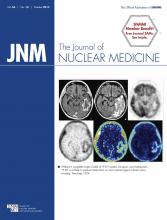Nanoparticles for cardiovascular imaging: Stendahl and Sinusas review the general features of nanoparticulate imaging agents and therapeutics and the challenges associated with clinical translation.
Page 1469
PET and malignant bone disease: Iagaru provides an invited perspective on the current status of 18F-fluoride PET imaging for skeletal disease and previews an article in this issue of JNM on its use in evaluation of metastatic disease.
Page 1476
New PET perfusion tracers: Brunken looks at the advantages and challenges of 18F-labeled tracers for myocardial perfusion imaging with PET and at a novel use of 18F-labeled fluoroalkylphosphonium salts described in an article in this issue of JNM.
Page 1478
RIT and vocal function: Ryu and colleagues assess the effect of radioactive iodine therapy on vocal function during the early follow-up period after total thyroidectomy for thyroid cancer.
Page 1480
Targeting GRPR, SSTR2, and CXCR4: Dalm and colleagues correlate mRNA expression of gastrin-releasing peptide, somatostatin, and chemokine C-X-C motif receptors with clinical and prognostic data to identify breast cancer patient groups suitable for specific radioligands targeting these receptors.
Page 1487
18F-FDG uptake and recurrence in AGC: Lee and colleagues study the predictive value of 18F-FDG PET for distant metastasis-free, peritoneal recurrence–free, overall recurrence-free, and overall survival after curative surgical resection in patients with advanced gastric cancer.
Page 1494
DOTATOC in NETs: Collamati and colleagues detail the uptake of DOTATOC and its time evolution in tumors and healthy organs to explore the potential suitability of radioguided surgery with β− decay in liver neuroendocrine tumor metastases.
Page 1501
Bone tumor burden and PET/CT: Rohren and colleagues describe a method to assess skeletal tumor burden with 18F-labeled sodium fluoride PET/CT and evaluate the reproducibility of these measurements in individuals with suspected skeletal metastatic disease.
Page 1507
Mental stress and adenosine ischemia: Wawrzyniak and colleagues use SPECT to characterize mental stress– and adenosine-induced changes in myocardial perfusion and neurohormonal activation in congestive heart failure patients with reduced left-ventricular function.
Page 1513
Arterial 18F-NaF uptake: Blomberg and colleagues investigate the relative effects of blood activity, renal function, injected dose, circulating time, and PET/CT instrumentation on quantification of arterial 18F-NaF uptake in healthy volunteers.
Page 1520
PET and parkinsonism survival: Hellwig and colleagues examine the prognostic value of 18F-FDG PET imaging of disease-specific metabolism patterns in suspected atypical parkinsonian syndromes and compare these results with those from clinical diagnoses.
Page 1527
PET and focal-onset dementias: Taswell and colleagues assess the accuracy of 18F-FDG PET metabolic imaging in detection of Alzheimer disease in patients with primary progressive aphasia or corticobasal syndrome.
Page 1534
Skeletal muscle glucose uptake and PET: Gheysens and colleagues identify the test–retest characteristics and variability of skeletal muscle glucose utilization within and between healthy subjects under basal conditions and assess different kinetic modeling strategies for 18F-FDG PET/CT.
Page 1541
177Lu-EDTMP vs. 153Sm-EDTMP: Thapa and colleagues compare the efficacy of these agents in systemic metabolic radiotherapy of bone pain in patients with skeletal metastases.
Page 1547
Brain tumor imaging: Fink and colleagues provide a practical overview of current anatomic and physiologic imaging of brain tumors, with a primary focus on MR and PET techniques that have shown utility in the care of brain tumor patients.
Page 1554
PET brain tumor volume assessment: Halle and colleagues compare agreement between PET- and histology-derived tumor volumes in an orthotopic glioblastoma rat model using 2 radiotracers, 2 image reconstruction algorithms, parametric imaging, and 2 image segmentation techniques.
Page 1562
GLP-1 receptor imaging: Bauman and colleagues describe preclinical development of exendin-4 derivatives for imaging of insulinomas with high-resolution PET at early or late time points after radiotracer injection.
Page 1569
18F-FATPs for cardiac PET: Kim and colleagues detail synthesis of and animal studies with 18F-labeled fluoroalkylphosphonium derivatives as myocardial perfusion agents for diagnosis of ischemic heart disease.
Page 1575
Fibrin-binding probes: Oliveira and colleagues report on preclinical studies to evaluate new probes labeled with 68Ga, 111In, or 99mTc as thrombus imaging agents for PET and SPECT.
Page 1581
β amyloidosis and rCBF detection: Maier and colleagues present a combined PET/7-T MR and 16.4-T microscopic MR imaging approach enabling quantification of amyloid load and regional cerebral blood flow in the brains of transgenic APP23 mice.
Page 1587
Imaging of NK cell trafficking: Galli and colleagues target natural killer cells using 99mTc-labeled anti-CD56 and image human natural killer cell trafficking in SCID mice bearing human cancers.
Page 1593
99mTc from a medium-energy cyclotron: Selivanova and colleagues evaluate the radioisotopic purity of 99mTc produced at medium energy (20–24 MeV) and report on draft quality control procedures and release specifications.
Page 1600
Clinical translation of 68Ga-NEB: Zhang and colleagues document first-in-human PET imaging with this radiolabeled NOTA-conjugated truncated form of Evans blue in studies differentiating hepatic hemangioma from other benign or malignant focal hepatic lesions.
Page 1609
Myocardial Patlak analysis: Thackeray and colleagues compare different image-derived input function volumes in the hearts of healthy mice and evaluate the effects of changing fit time interval on Patlak uptake kinetics.
Page 1615
Modeling radiopharmaceutical kinetics: Shuryak and Dadachova explore simpler and enhanced pharmacokinetic process modeling using continuous probability distributions of first-order rates and compare these with the performance of discrete-rate models.
Page 1622
Nuclear medicine in Latin America: Páez and colleagues report on the status of nuclear medicine in Latin American and Caribbean countries and include recent findings on technology and human resources from the International Atomic Energy Agency.
Page 1629
- © 2015 by the Society of Nuclear Medicine and Molecular Imaging, Inc.







